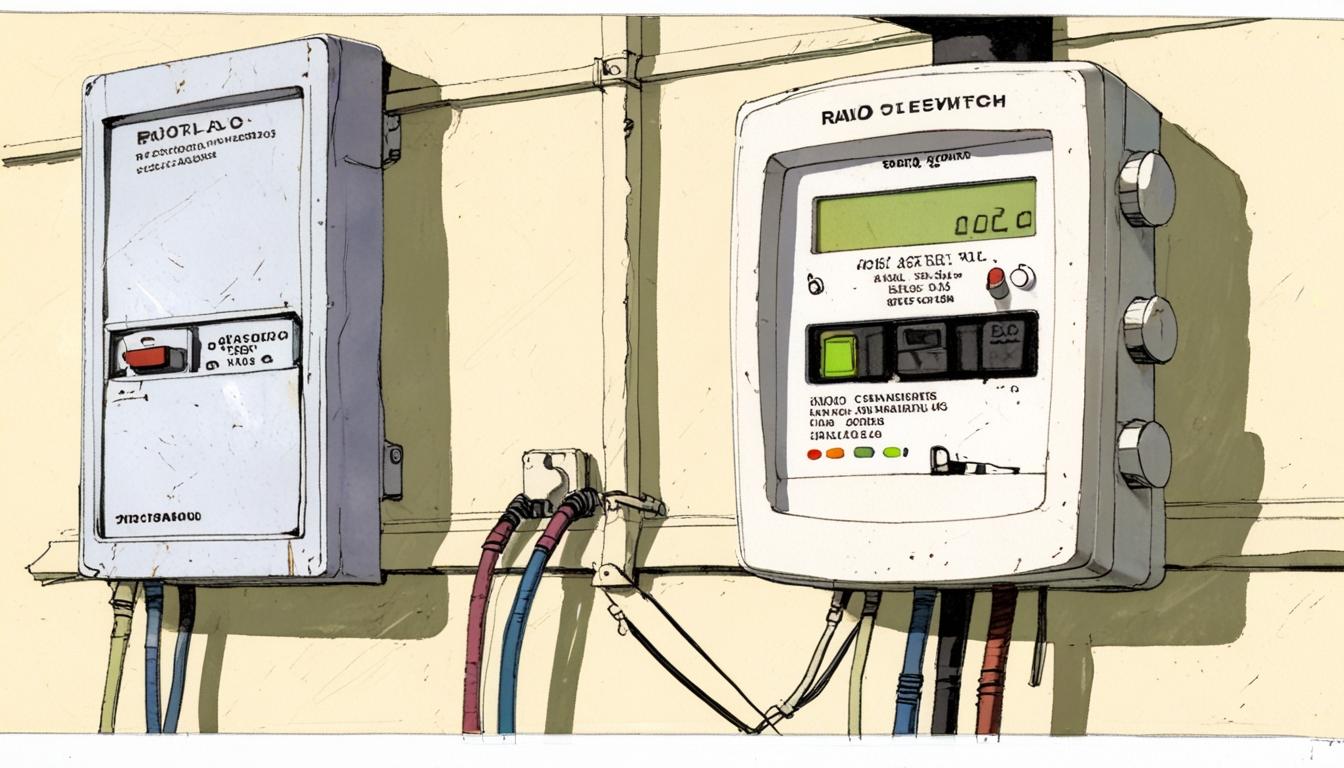With over 160,000 households reliant on the outdated Radio Teleswitching Service, Scotland must accelerate the adoption of smart meters by the 2025 deadline to avoid service disruptions and rising energy costs, especially in rural and electric heating-dependent communities.
The impending decommissioning of the Radio Teleswitching Service (RTS) poses significant challenges for Scottish energy consumers, particularly those in rural areas. As of March 8, 2023, over 160,000 households in Scotland remain dependent on this antiquated system, which utilises radio signals from BBC Radio 4 to manage electricity tariffs across various accounts, including the Total Heat Total Control from OVO and Economy 7 or 10 tariffs. In a landscape where energy prices are on the rise, this transition has become critical not only for the comfort of households but also for safeguarding against escalating costs.
RTS meters, which have served their purpose since the 1980s, will fall out of service as the BBC moves towards digital broadcasting, rendering the long-wave frequency obsolete. This makes it imperative for consumers with RTS meters to upgrade to smart meters, which offer enhanced benefits, including automatic reading submissions and the ability to monitor energy usage in real-time. However, adopting smart meter technology has proven sluggish in Scotland, with just 43% of domestic electricity meters classified as smart, significantly lower than the broader UK average. In some areas, such as the Shetland Isles, coverage is alarmingly low, with rates as little as 10%.
Identifying whether a household has an RTS meter is crucial. Consumers should look for signs such as automatic switching between tariff rates or the presence of a device labelled ‘Radio Teleswitch’ near their meter. Those uncertain about their meter type are advised to contact their energy supplier for clarification. The transition to smart meters is not just a technical upgrade, but a necessary step for many households, especially those relying on electric heating due to the lack of gas supplies in rural or high-rise settings.
The energy regulator Ofgem has issued warnings indicating that failure to upgrade RTS meters by the June 30, 2025 deadline could result in severe consequences, including loss of heating and hot water. Upgrading to smart meters will help alleviate these risks and may also lead to access to more competitive tarieven. Yet, the prospect of upgrading has not come without concerns; issues around data privacy and the reliability of smart meters have been raised by consumers worried about surveillance and billing inaccuracies.
Beyond individual households, the Scottish Government has taken measures to ensure that energy suppliers are prioritising the replacement of RTS meters to mitigate service disruptions. Reports suggest that approximately 250,000 properties in Scotland currently utilise RTS, which represents over a quarter of the UK’s RTS-dependent households. Energy suppliers are urged to communicate proactively with customers to arrange the necessary upgrades ahead of the impending service shutdown.
Moreover, as the transition unfolds, various stakeholders, including housing associations, are highlighting the implications for tenants in properties reliant on electric heating. The Scottish Federation of Housing Associations has emphasized the urgency of timely upgrades to avoid impacting tenants’ comfort—particularly vital for those in social and supportive housing settings.
The slow rollout of smart meters in Scotland has been attributed to several factors, including technical challenges in remote areas where mobile signals are weak and the logistical hurdles of reaching isolated communities. In the face of these challenges, the industry remains engaged in discussions about potential temporary solutions, such as pre-programmed smart meters, to ensure no household is left vulnerable after the RTS is phased out.
As the decommissioning date approaches, it is clear that both the Scottish Government and energy suppliers must accelerate efforts to facilitate this transition. By actively upgrading systems and addressing consumer concerns, stakeholders can help ensure that Scottish households are not only compliant with the new regulations but also set up for a more sustainable and cost-effective energy future.
Reference Map
- Paragraph 1: [1]
- Paragraph 2: [2], [3]
- Paragraph 3: [1], [4]
- Paragraph 4: [5]
- Paragraph 5: [6]
- Paragraph 6: [4], [7]
- Paragraph 7: [5]
- Paragraph 8: [1], [2]
Source: Noah Wire Services
- https://www.heraldscotland.com/news/25141071.scotland-hardest-hit-big-bbc-radio-switch-off-crisis/?ref=rss – Please view link – unable to able to access data
- https://www.heraldscotland.com/news/24062790.1000s-scots-face-rising-energy-costs-bbc-radio-switch-off-puzzle/ – Thousands of Scottish households face potential higher energy prices due to the impending switch-off of the Radio Teleswitching Service (RTS). The RTS, which enables electricity suppliers to switch meters between different energy tariffs, is set to be decommissioned at the end of March. Scotland has the lowest smart meter coverage in Britain, with only 43% of domestic electricity meters being ‘smart’ as of March 31, 2023. This slow rollout, particularly in rural areas, could lead to increased energy costs for affected households.
- https://www.energyadvice.scot/radio-tele-switched-meter-rts/ – The Radio Teleswitching Service (RTS) is being phased out as the BBC transitions to digital radio, rendering the RTS signal obsolete. Energy suppliers are responsible for replacing RTS meters with smart meters before the service ends on June 30, 2025. Consumers are advised to contact their electricity supplier to arrange for a smart meter upgrade. In areas without smart meter coverage, temporary pre-programmed smart meters may be installed, though this is yet to be confirmed.
- https://www.gov.scot/publications/decommissioning-of-the-radio-teleswitch-service-letter-to-energy-suppliers/ – The Scottish Government has issued a letter to energy suppliers regarding the decommissioning of the Radio Teleswitch Service (RTS), scheduled for June 2025. Approximately 250,000 properties in Scotland currently use RTS, accounting for over a quarter of all RTS customers in the UK. The government urges energy suppliers to prioritize upgrading RTS customers to smart meters to prevent service disruptions and ensure a smooth transition.
- https://www.sfha.co.uk/news/news-category/sfha-news/news-article/rts-shutdown-and-your-tenants – The Scottish Federation of Housing Associations (SFHA) highlights the impact of the Radio Teleswitch Service (RTS) shutdown on tenants. Properties relying on RTS, especially those without gas supply and using electric heating, need to upgrade to smart meters before June 2025 to avoid disruptions in heating and hot water services. The SFHA emphasizes the importance of timely upgrades to ensure tenants’ comfort and energy efficiency.
- https://www.heraldscotland.com/news/23782662.bbc-radio-switch-off-mean-higher-energy-bills-scots/ – The BBC’s plan to switch off the Radio Teleswitching Service (RTS) by March 2024 could lead to higher energy bills for thousands of Scottish households. The RTS system, which allows suppliers to switch meters between different energy tariffs, is being decommissioned, and the rollout of smart meters in Scotland is lagging behind the rest of Great Britain. This delay may result in increased energy costs for affected consumers.
- https://www.shetland.gov.uk/rts – Shetland Islands Council urges residents to check their electricity meters ahead of the Radio Teleswitch Service (RTS) switch-off on June 30, 2025. Approximately 5,000 RTS meters are in use in Shetland. The council is collaborating with partners to raise awareness and advises residents to contact their energy suppliers to arrange for smart meter installations before the service ends.
Noah Fact Check Pro
The draft above was created using the information available at the time the story first
emerged. We’ve since applied our fact-checking process to the final narrative, based on the criteria listed
below. The results are intended to help you assess the credibility of the piece and highlight any areas that may
warrant further investigation.
Freshness check
Score:
9
Notes:
The narrative discusses a 2023 event—the decommissioning of the Radio Teleswitching Service with a deadline in June 2025, consistent with recently evolving developments. The information aligns with ongoing energy sector changes and official government timelines, indicating high temporal relevance and freshness. No indications of recycled or outdated news were found.
Quotes check
Score:
8
Notes:
The narrative does not include explicit direct quotes attributed to individuals; it references warnings from Ofgem and statements from the Scottish Federation of Housing Associations. These institutional references seem consistent with official communications available publicly, though no earliest original statements with exact dates were explicitly sourced. The absence of direct, attributable quotes lowers this score slightly.
Source reliability
Score:
8
Notes:
The narrative originates from Herald Scotland, a recognised Scottish news outlet with a reputation for regional news accuracy. The topic is supported by official government references and regulatory bodies like Ofgem, enhancing credibility. While Herald Scotland is reputable, it is not among the top global outlets, so reliability is considered strong but not at the highest international tier.
Plausability check
Score:
9
Notes:
The claims about the phasing out of RTS meters due to BBC digital switchover and the need for smart meters are technically plausible and consistent with known UK digital transition policies. The reported consumer and regional statistics on smart meter adoption appear realistic and are corroborated by governmental and housing association involvement. Concerns about data privacy and technical challenges are well-known issues in smart meter rollouts. The narrative is plausible and aligns well with recent energy infrastructure changes.
Overall assessment
Verdict (FAIL, OPEN, PASS): PASS
Confidence (LOW, MEDIUM, HIGH): HIGH
Summary:
The narrative is a fresh, up-to-date report based on reliable regional journalism and official sources, discussing a current and unfolding issue in Scotland’s energy sector. It contains no recycled or outdated information, lacks direct unverifiable quotations, and presents highly plausible claims supported by known government policies and industry trends. The reliability of the Herald Scotland narrative and corroborating official references underpins a high-confidence pass.













